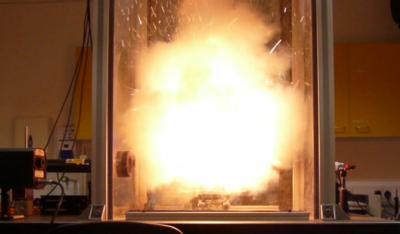Black body and black body radiation
By Prevost’s theory of
exchanges, bodies in temperature equilibrium with their surroundings emit
radiation of the same character and intensity as that which they absorb.
Lampblack, for examples, possesses the power of absorbing nearly all the
radiation which is incident upon it and retains this power as its temperature
is raised. Such a body having the power to absorb radiation of all wave-lengths
completely is termed a black body. No
material surface absorbs all the radiant energy incident on it. Lampblack reflects
about 2% and so it approximates very closely to a black body. A black body is
realized experimentally by having a uniform temperature enclosure with an
aperture, small in comparison with the internal dimensions of the enclosure,
through which the radiation may emerge. The emission of thermal radiation from
and the absorption of radiation from and the absorption of radiation of all
wave-lengths passing into, such an enclosure is complete. This radiation from
such an enclosure is known as black body
radiation or more appropriately full
radiation. The smaller the aperture, the more completely is the radiation
black. So a correction is to be applied for the lack of blackness due to the
finite size of the aperture. This is due to the fact that some of the radiation
coming from the wall is able to escape out and the state of thermodynamic
equilibrium does not hold. This is avoided by Fery in his particular type of
black body.
Application of Kirchhoff’s law to astrophysics
Kirchhoff’s law was
responsible for the birth of two entirely new branches of science, astrophysics
(physics of the suns and stars) and spectroscopy.
In 1680 Newton had shown that the sunlight can be
decomposed by means of a prism into seven colors of the rainbow, but
Fraunhofer, who repeated the experiment in 1801 with better instruments, found
to hiss surprise that the spectrum was not continuous but crossed by dark
lines. He could not account for the origin of these dark lines, neither did any
of his contemporaries. But he realized their great importance, measured them
and catalogued their wave-lengths. He also investigated the light from stars
and found similar dark lines in their spectra. Other physicists, notably,
Fizeau observed that if the solar spectrum is examined side by side with the
spectrum from a sodium flame, the two yellow lines of the sodium spectrum
occupy the same place as the Fraunhofer D-lines in the solar spectrum. Similar
is the case with the hydrogen spectrum. Although these facts paved the way for
a possible solution, the dark lines of Fraunhofer remain unexplained, until
Kirchhoff completely solved the problem on the basis of his law.
Kirchhoff arrived at the
same law from thermodynamic reasoning and apply it to explain the dark lines as
follows:
Sodium can emit the D-lines
when it is excited; hence it can also absorb the same light when white light
falls upon it and allows other light to pass through it unaffected. The gases
in the outer cooler mantle round the sun, therefore, deprive the continuous
spectrum from the central mass of the lines they themselves can emit and give
rise to the dark lines. The D-lines (absorption spectrum of sodium) in the
Fraunhofer spectrum prove that there is sodium in the sun’s atmosphere.
Similarly, the other dark lines testify to the presence of their respective
elements in the sun’s atmosphere. The presence of dark lines in the spectra of
stars is accounted for in similar manner. It is by the analysis of such dark
lines, one is able to tell of what elements the analysis of such dark lines,
one is able to tell of what elements the cooler atmosphere surrounding the sun
and stars are composed.
Kirchhoff’s discovery is of
much greater importance than the mere success in explaining the fraunhofer
bands. It clearly asserts that every
different type of atom, when it is properly excited emits light of definite
wavelength which is characteristic of the atom.
Radiation pyrometers
Pyrometers are instruments
for measuring high temperatures by means of radiation. In most thermometers the
elements must be brought into contact with the body and if the temperature is
too high the element is likely to melt. The radiation method does not depend
upon contact with the body and so has not this limitation, but does assume that
the body is a perfect black body. Frequently this will not be so and as a
result the measured temperature will be lower than the actual.





No comments:
Post a Comment